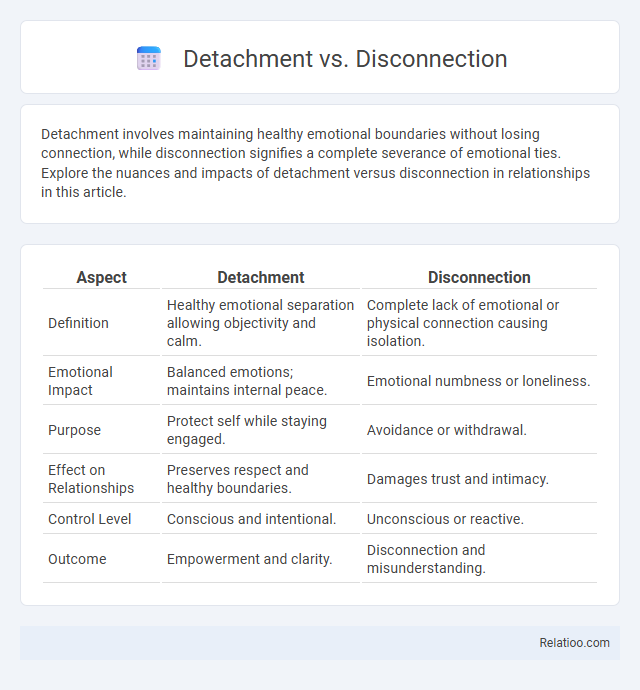Detachment involves maintaining healthy emotional boundaries without losing connection, while disconnection signifies a complete severance of emotional ties. Explore the nuances and impacts of detachment versus disconnection in relationships in this article.
Table of Comparison
| Aspect | Detachment | Disconnection |
|---|---|---|
| Definition | Healthy emotional separation allowing objectivity and calm. | Complete lack of emotional or physical connection causing isolation. |
| Emotional Impact | Balanced emotions; maintains internal peace. | Emotional numbness or loneliness. |
| Purpose | Protect self while staying engaged. | Avoidance or withdrawal. |
| Effect on Relationships | Preserves respect and healthy boundaries. | Damages trust and intimacy. |
| Control Level | Conscious and intentional. | Unconscious or reactive. |
| Outcome | Empowerment and clarity. | Disconnection and misunderstanding. |
Understanding Detachment and Disconnection
Understanding detachment involves recognizing a healthy emotional separation that allows individuals to maintain personal boundaries without losing empathy or connection. Disconnection refers to a more severe break in relationships or emotional awareness, often leading to isolation or impaired social functioning. Detachment is a conscious process that fosters resilience, whereas disconnection is typically involuntary and detrimental to emotional well-being.
Core Differences Between Detachment and Disconnection
Detachment involves maintaining emotional boundaries while staying aware and present, enabling you to engage without being overwhelmed by feelings. Disconnection refers to a complete shut-off from emotions or relationships, often leading to isolation and lack of awareness. Understanding these core differences helps your emotional health by promoting healthy boundaries instead of emotional numbness.
Psychological Foundations of Detachment
Detachment in psychology refers to the ability to maintain emotional distance from situations or people to regulate responses and promote mental health, contrasting with disconnection, which implies a breakdown in emotional or cognitive integration often linked to disorders like dissociation. Unlike disconnection, detachment supports adaptive functioning by fostering mindfulness and self-awareness, enabling individuals to observe thoughts and emotions without becoming overwhelmed. This psychological foundation of detachment emphasizes intentional awareness and emotional regulation, distinguishing it from pathological states of disconnection where individuals lose coherent self-experience.
The Emotional Impact of Disconnection
Disconnection often leads to feelings of loneliness, anxiety, and emotional numbness, negatively affecting Your mental well-being. Unlike detachment, which can be a conscious and healthy coping mechanism, disconnection typically involves an involuntary emotional withdrawal from relationships and experiences. Understanding the emotional impact of disconnection is crucial for addressing issues such as depression and impaired social functioning.
Benefits of Practicing Healthy Detachment
Practicing healthy detachment enhances emotional resilience by allowing you to maintain clarity and calmness in stressful situations without becoming overwhelmed. It supports balanced relationships by fostering empathy while respecting personal boundaries, preventing codependency or emotional burnout. This mindful approach encourages self-awareness and inner peace, empowering you to engage with life authentically and with greater control over your reactions.
Risks and Consequences of Disconnection
Disconnection from others often leads to significant psychological risks such as increased loneliness, depression, and anxiety, impairing social functioning and emotional well-being. Unlike detachment, which can serve as a healthy coping mechanism to maintain boundaries, disconnection results in a breakdown of communication and trust, potentially fostering isolation and misunderstanding. Long-term consequences include diminished support networks and decreased resilience to stress and mental health challenges.
Signs You Are Detached vs. Disconnected
Signs you are detached include emotional numbness, decreased empathy, and a sense of inner calm despite external stress, whereas disconnection often manifests as feelings of loneliness, withdrawal from relationships, and lack of communication. Detachment allows for healthy boundaries and objective perspective in your interactions, but disconnection can lead to isolation and hinder emotional growth. Recognizing these differences can help you address underlying issues and improve your emotional well-being.
Cultivating Detachment Without Losing Connection
Cultivating detachment involves maintaining emotional balance while staying connected to relationships and experiences, unlike disconnection which implies complete withdrawal or isolation. Detachment allows individuals to observe their thoughts and feelings without getting overwhelmed or overly attached, promoting mental clarity and resilience. Practicing mindful awareness and setting healthy boundaries helps nurture detachment while preserving meaningful connections in both personal and professional settings.
Overcoming Unhealthy Disconnection
Overcoming unhealthy disconnection involves recognizing the difference between detachment, disconnection, and avoidance to cultivate emotional resilience and maintain healthy relationships. Detachment allows you to create boundaries without cutting off your emotions, fostering self-awareness and balanced interactions. Prioritizing mindful detachment over disconnection enables your emotional well-being while preserving meaningful connections.
Embracing Connected Detachment for Wellbeing
Embracing connected detachment involves maintaining emotional boundaries while staying engaged in relationships, fostering wellbeing by reducing stress and enhancing clarity. Unlike disconnection, which severs emotional ties, connected detachment allows for compassionate presence without over-identification. This balanced approach supports mental health by promoting resilience and mindful interactions in personal and professional spheres.

Infographic: Detachment vs Disconnection
 relatioo.com
relatioo.com